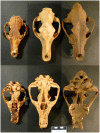Could direct killing by larger dingoes have caused the extinction of the thylacine from mainland Australia?
- PMID: 22567093
- PMCID: PMC3342279
- DOI: 10.1371/journal.pone.0034877
Could direct killing by larger dingoes have caused the extinction of the thylacine from mainland Australia?
Abstract
Invasive predators can impose strong selection pressure on species that evolved in their absence and drive species to extinction. Interactions between coexisting predators may be particularly strong, as larger predators frequently kill smaller predators and suppress their abundances. Until 3500 years ago the marsupial thylacine was Australia's largest predator. It became extinct from the mainland soon after the arrival of a morphologically convergent placental predator, the dingo, but persisted in the absence of dingoes on the island of Tasmania until the 20th century. As Tasmanian thylacines were larger than dingoes, it has been argued that dingoes were unlikely to have caused the extinction of mainland thylacines because larger predators are rarely killed by smaller predators. By comparing Holocene specimens from the same regions of mainland Australia, we show that dingoes were similarly sized to male thylacines but considerably larger than female thylacines. Female thylacines would have been vulnerable to killing by dingoes. Such killing could have depressed the reproductive output of thylacine populations. Our results support the hypothesis that direct killing by larger dingoes drove thylacines to extinction on mainland Australia. However, attributing the extinction of the thylacine to just one cause is problematic because the arrival of dingoes coincided with another the potential extinction driver, the intensification of the human economy.
Conflict of interest statement
Figures


References
-
- Vitousek PM, Mooney HA, Lubchenco J, Melillo JM. Human domination of Earth's ecosystems. Science. 1997;277:494–499.
-
- Blackburn TM, Cassey P, Duncan RP, Evans KL, Gaston KJ. Avian extinction and mammalian introductions on oceanic islands. Science. 2004;305:1955–1958. - PubMed
-
- Savidge J. Extinction of an island forest avifauna by an introduced snake. Ecology. 1997;68:660–668.
Publication types
MeSH terms
LinkOut - more resources
Full Text Sources
Research Materials

